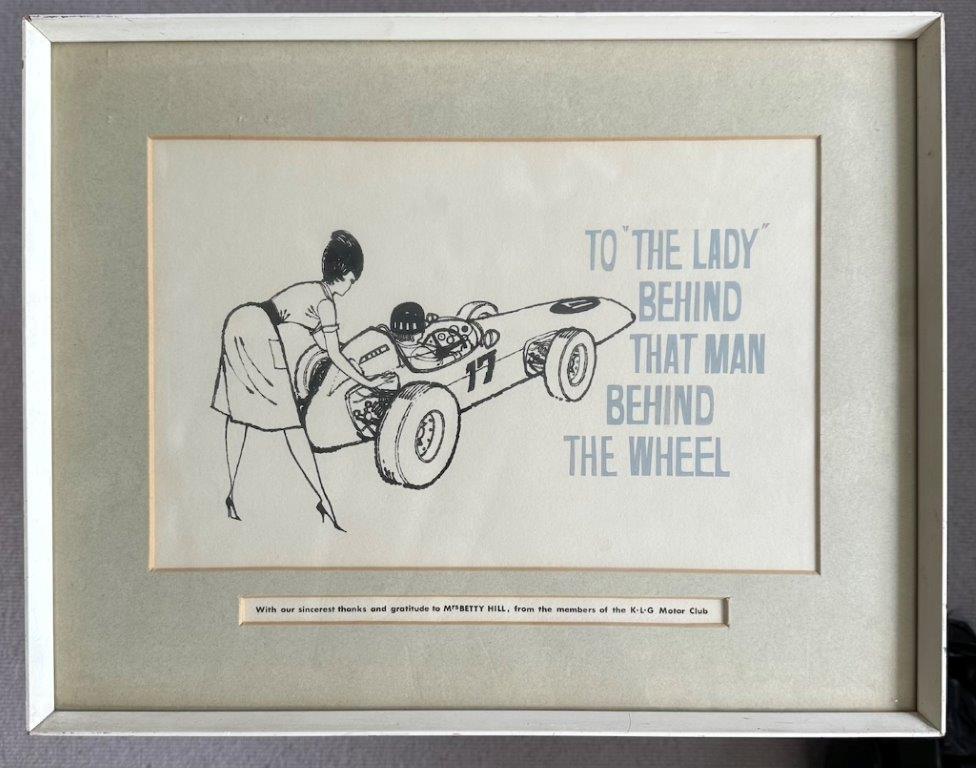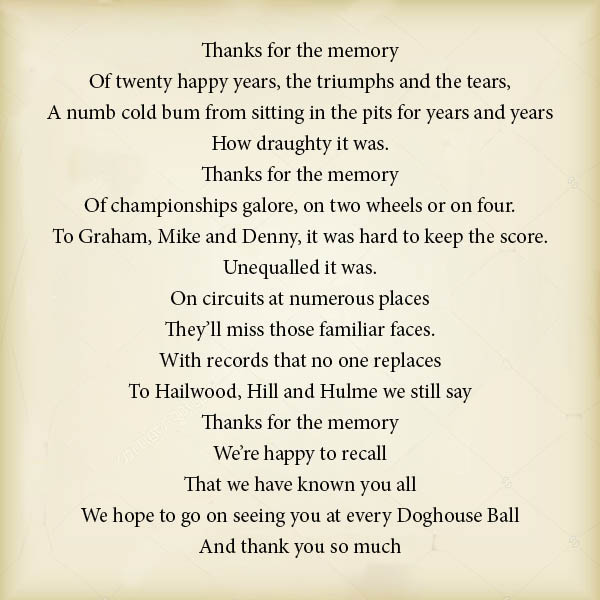By Brigitte Hill
Valentine’s is always a happy coincidence as the 15th February is my Father’s birthday!
It does make me smile that this good-looking, fun loving man he was well known for being – almost as much as he was for his record-breaking career – was born so close to the day we celebrate love, romance and all that conjures.
And when I look back, he certainly was that person, possessing endless charm and extraordinary wit that he deployed so effortlessly in front of crowds and on television. With my mother, Bette, by his side.
Dubbed the “First Lady” of Formula 1, she was called The Lady behind that Man behind the Wheel. She’s quoted as saying, “Socially it was wonderful, with all the parties. We were all pretty glamorous girls in those days, and we looked after ourselves and were made up properly to go to the races and had nice clothes to sit on pit counters and get filthy dirty, but it didn’t matter.”

In The Doghouse
She was one of the founding members and later President of The Doghouse Owners’ Club, the nickname for the Women’s Motor Racing Associates Club. The club was born when a group of wives had got fed up with their husbands getting up from the dinner tables in hotels and at dinner to huddle in a corner talking shop – leaving their significant others sitting alone at their different tables around the room. As Betty Brabham was sitting on her own a couple of the girls and my mother walked over to join her. Betty said “Jack’s in the doghouse” and that did it!
They decided to start a club for racing drivers’ wives and as the Doghouse grew, these formidable and wonderful women also set out to use it as a platform to raise money for charities, with half the money going towards the Doghouse benevolent fund to assist wives and children of any breadwinners who might be killed or injured to avoid any immediate financial worries dependents might have on top of tragedy.
It covered everyone including the wives of mechanics, journalists or anyone connected with the sport. It was also a wonderful way of uniting all together so they would never lack company at race meetings and meant we children had somewhere warm and dry to be during long days at the circuits!
My mother said that the response from the men was tremendous, and my father supported her one hundred per cent. Jack Brabham and Les Leston supported their wives Betty and Doreen and Eba Grant was backed to the hilt by her husband Gregor who was the founding editor of Autosport magazine.
Garden fetes, celebrity cricket matches, pantomimes where our dog Honey dressed in a ruff around her neck was enlisted to accompany Graham the Genie on to the stage at the Mermaid Theatre, all hotly anticipated, wonderful, wonderful events where everyone mucked in and the racing drivers ran stalls, coconut shies, veteran car rides for children and many other showstoppers which drew the crowds and raised money.
Then there was the biennial glamorous and famous Doghouse Ball and Cabaret, created, written, produced and performed by the Doghouse ladies.
During the 1975 cabaret as Mum sat on the stage with Pauline Hailwood, still in their can-can dresses, she looked at Graham as she sang Thanks for the Memory, for which they had written the words, and sang the words to my father. Someone who had been sitting in the audience, as Dad was, said to her afterwards: “I didn’t watch you during that song – I was watching Graham – and he never took his eyes off you”.
Here are the words:

When I read my father’s autobiography, Graham, I realise it is like a love letter to my mother. And in turn hers, The Other Side of the Hill, is her love letter to him. Her last words are “To finish this book is difficult, for the memories keep crowding in. I realise that I could go on for ever remembering the laughter and tears, excitement and disappointments, the sheer joy of having lived as the other half of a beautiful man called Hill.”
World Champion
Both my parents believed that the more you put into life, the more you get out of it. It’s a mantra they lived by and also instilled in us, their children.
My father’s career took off at the beginning of the 1960s. The country had recovered from the tough years following WWII and Britain was booming.
It was an exhilarating time… of self-expression, creativity and stepping outside the social norms. And, in many ways, Britain was at the epicentre of this cultural explosion. Beatlemania swept the world. Mary Quant revolutionised fashion. England won the world cup. And my father triumphed on the race track. My parents fully embraced the 1960s and lived life to its fullest.
My father knew how transient fame is, and also how he could use it to benefit others. To help disadvantaged young people, he started the Springfield Boys Club, now Springfield Club for Young People, in Big Hill in Hackney. He was very modest about his role and was always keen to recognise the hard work of the team who invested their time in shaping the lives of young people at the club. When he was awarded the OBE, he called it “Other Buggers’ Efforts”.
Although we were only children when my father won his two F1 World Championships I know that he didn’t take the mantle of being World Champion lightly.
After his first World Championship win, he wrote: “It takes some time to realise that you are, in fact, World Champion. ‘World’ is such a big word, but when it does sink in you begin to realise what a terrific responsibility you owe to your sport, the people who put you there and to everybody around you. You try to conduct yourself in a manner befitting a World Champion – and that isn’t easy – but it isn’t until you start getting invited to events and being announced as the World Champion that you fully realise what it means.”
I think that this quote captures a general attitude he had, not just to motor racing, but to life.
Style icon
My father was the face of motor racing in Britain in the 1960s. With his dashing good looks, flowing mane and trademark moustache, he was many people’s idea of what a racing driver should be like. Even after a full race of 60 laps under a helmet, his hair would still look perfect.
His popularity during the 60s and 70s transcended sport. He was one of the first sportsmen to become a media celebrity, as well-known for his personality as his record-breaking career.
He was definitely a larger-than-life character, who possessed endless charm and extraordinary wit, which he deployed effortlessly, whether he was making an after-dinner speech, or being interviewed on television.
In one memorable television appearance on Sports Review of the Year 1965 alongside Jim Clark, David Coleman put the question to my father, “You’ve travelled most of the way this season behind Jim. What would you say is his most outstanding characteristic as a racing driver?”
My father’s typical deadpan response was, “Well, I think getting across the line first. Bit irritating actually.”
I’m going to share that interview link with you because it does really bring to life his wicked sense of humour that my mother so loved about him.
I hope it makes you smile.
Happy Birthday, Dad, and Happy Valentine’s to you all.
Brigitte
